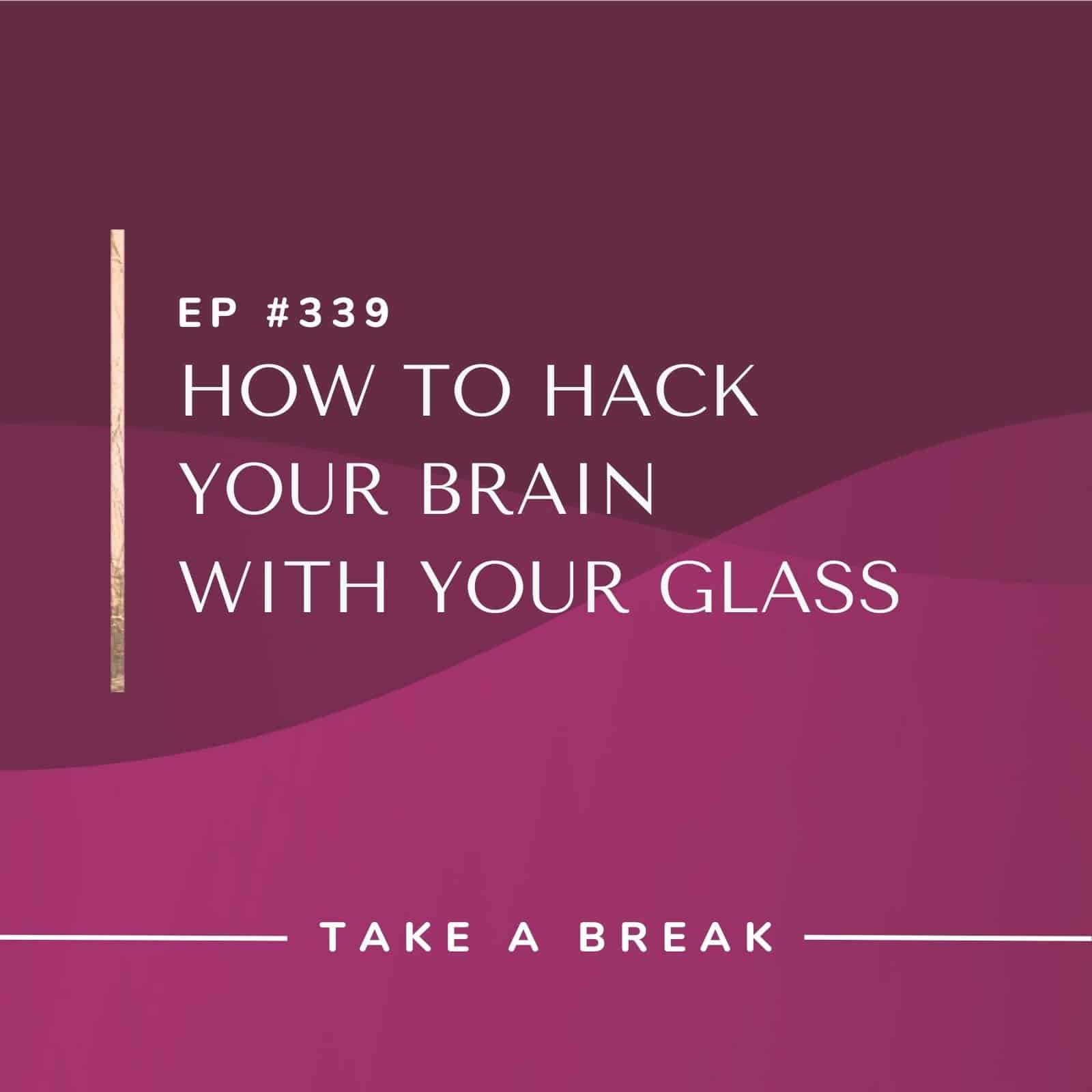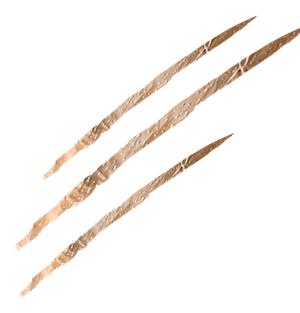The Podcast
Take a Break

Episode #339
How to Hack Your Brain With Your Glass
subscribe & never miss
Tuesday’s Episode

A champagne flute on a special occasion, a delicate martini with friends, or a classic wine glass that you enjoy, the shapes of glassware can be fun and exciting.
When opting for non-alcoholic beverages, the glassware can be less than desirable. It isn’t so exciting to drink a mocktail from a soda glass.
This week, learn how to leverage the think, feel, act cycle when it comes to glassware, and understand the connection between the glass you drink from and your drinking habit.
What You’ll Discover

How to use glassware as a tool, while saying no to a drink.

Where unconscious conditioning could be affecting your relationship with alcohol.

A tool to help you understand your conditioning and make room for change.
Featured on the show

Receive my 16 techniques for talking back to your excuses by signing up for my membership program.
Transcript
You are listening to the Take A Break podcast with Rachel Hart, Episode 339.
Whether you want to drink less or stop drinking, this podcast will help you change the habit from the inside out. We’re challenging conventional wisdom about why people drink and why it can be hard to resist temptation. No labels, no judgment, just practical tools to take control of your desire and stop worrying about your drinking. Now, here’s your host, Rachel Hart.
Hey, everybody, we are talking about hacking your brain with your glass, with the drinkware that you select to use. This came up recently inside the membership. I realized I hadn’t done a podcast episode about this topic. I’ve talked before, on the podcast, about stemware, especially the super sizing of stemware and drinkware, and how that can lead to drinking more. We will link to that episode in the show notes.
But I haven’t talked about this episode. Really, how to hack your brain and your experience with the glass that you choose. It’s such a simple trick, it really is. But here’s the thing, when you experiment with it, the reason why I think it can be so beneficial is that you start to get some new awareness and new insight about your desire.
That maybe your desire isn’t just about alcohol. It isn’t just about you love this drink. But there are these unconscious messages that we’ve all absorbed that are contributing to your experience. I will tell you this, the trick is really simple, but I want you to understand the mechanics behind it.
So, all we’re really doing is drinking something that is nonalcoholic from a glass that is typically reserved for something that is alcoholic. I’m talking about drinking seltzer and lime from a wineglass, or using one of these tiny little dainty cocktail glasses for something nonalcoholic.
Now, here’s the thing, before you roll your eyes and think, “This is stupid. You don’t understand what’s going on with me or my situation. This is not going to solve my problem.” I say that, because there was definitely a version of me who would have heard this advice and thought exactly that. Like, what is this woman talking about?
Before you tune out, I do want you to consider why this can work. Because it has everything to do with a think-feel-act cycle, which is what we talk about all the time here, right? The idea that the decisions that we’re making to drink don’t just happen. There’s a thought and a feeling, and we need to see what they are.
We need to understand all of the thoughts and feelings that become part of the habit, that usually we can’t see at all, so that we can actually learn how to change the habit sustainably. Because here’s the thing, if you understand what’s happening behind the scenes in your brain, it’s going to give you this new foundation, this new place to start to try to change the habit.
So, it’s not just about just say no, or grit your teeth. What I want you to do, I want all of you to remember way back when, that first memory that you had when you first encountered one of those special glasses that was reserved for alcohol. I will tell you, one of my first memories is my parents making frozen daiquiris, which I think is a pretty clear sign that I am a child of the 80s.
But I will tell you, I remember them doing this. I remember that I was really little, maybe I was five, six or seven, and they would do it on the weekends. It was like a special thing. It was a little bit of a production, right? They had to lug out the blender, they had to get the frozen daiquiri mix. Which, by the way, I also remember was this bright, beautiful pink. So, me, as a little girl, thought this was a very appealing looking drink.
I also remember that my dad would go into our dining room, and he would go to this special cabinet where they kept all the special glasses that I was not allowed to touch. I still remember this cabinet. It had these beautiful old glass leaded doors.
You know how sometimes older antique glass is a little thicker or beveled, or it has these imperfections in it that actually, not only makes the glass really beautiful, but it means that what you’re seeing on the other side you don’t see as clearly. So, there’s this little added bit of maybe mystery or beauty that’s added.
I remember this cabinet. I remember the doors. I remember all the glasses inside, I remember also, that I was not allowed to touch them. Right? This very clearly was not drinkware for kids. It was only for adults to use. It was only for them to use on special occasions. All the glasses were different shapes and sizes. Just so much more interesting and beautiful than the plastic cup that I was given.
Now, I will say this, I know it sounds silly, right? You’re like, “Rachel, it’s just a glass. Who cares?” But remember, this is me going back in time. I want you to go back in time, and really go back to that place of you being this little person with a little brain trying to make sense of the world, seeing all of this. Getting all of these messages without necessarily someone in your life, saying it out loud to you. We’re still absorbing these messages.
To me, it was like, “Ooh, it’s fancy. It’s so fancy. I want to be fancy, too. It’s very adult.” That was another thing that I remember, really being like, “Yeah, but I want to be treated like an adult too.”
I will see this in my five-year-old right now. He is the exact same way. He doesn’t want to be treated like a little kid. He doesn’t want the little kid plates, or the little plastic cups. He wants what he sees his father and his mother eating off of and using for our drinks.
So, I just think it’s important to go back and remember and realize, even if you’re like, “This is silly, I’m not sure how this is going to help me,” to just remember you too were once a little kid absorbing all these messages about what was off limits, what was fancy, what was special, what was sophisticated, what was adult.
Even if right now you’re like, “Yeah, but this is dumb. I logically know there’s nothing special about this glass,” you’ve had decades and decades and decades of being told this is special, and this is adult. The idea that you can just immediately get rid of all of that conditioning doesn’t really make sense, right? It’s in there.
Here’s the thing, how does this help you hack your brain when you’re drinking something nonalcoholic? Well, imagine going to a restaurant. I think about, often I’ll go to a restaurant, sit down at the table, and there are already wine glasses on the table. Glasses, that a long time ago my little brain attached labels to, right? “Ooh, this is fancy. It’s special, it’s adult.”
So, I’ll be sitting at the table, the waiter will come over, and he or she will ask if I would like to see the wine list. When I say, “Oh, I won’t be drinking tonight,” what happens? What does the waiter do? You know what the waiter does, they take the wine glasses away. They take it away as if it’s like, “No fancy glasses for you.”
Again, it’s funny because even if you’re logically thinking, “I shouldn’t care. This is stupid to care about this. It’s not a big deal,” it still can feel a little bit of a big deal. Right? We can’t just erase all that conditioning that we have. You can’t just get rid of it. Your brain absorbed these messages.
So, just noticing that, noticing what happens when they swipe the wine glasses off the table, does it create even just a small, little internal emotional experience for you? This will happen too, that sometimes I’ll order a mocktail, and instead of bringing it out in the cute, little, delicate, fancy glasses that I see the other cocktails coming out in, they bring it out in a pint glass. The same glass that they’re serving soda in.
And every time, it does not matter that I understand the glass is neutral. It has no meaning. It’s not creating my feelings every time I have a little moment of disappointment. I’m just like, “Where is my fancy glass? I want a fancy glass, too.”
I was talking about this with a friend the other day. She just replaced her wedding ring. She was talking about going to the jeweler to pick up the ring, and it was this really special moment. She was there with her husband and some friends, and they were sipping champagne out of beautiful champagne glasses.
You know what? It totally made me think of when I picked up my wedding ring, which of course, was like this special day for me too. I remember so vividly, when they offered me champagne and I turned it down, the guy was like, “Oh, would you like some water?” I said yes, then he proceeded to give me one of those squat, eight-ounce, mini, plastic water bottles.
I was just sitting there like, “Really, people? That’s what you’ve got for me? That’s what you’ve got for someone who doesn’t drink? You’re just going to give me this squat, eight-ounce plastic bottle? I just spent a lot of money here.”
So, again, we can make the argument, “Oh, God, who cares? I’m being silly. This isn’t a big deal. It’s just a glass.” But at the same time, we can also decide to work with all of that conditioning that we’ve got. Right? Because think about it. Think about how happy I would have been if they were like, “Oh, you’d like some water? Here’s some lovely, chilled, sparkling water in a fancy flute glass for you, too.” I would have been so happy.
I know that that water is not any better or any fancier because of the glass that it’s in. I know that it is just the decades of conditioning that I’ve got. But I’m like, okay, still, why not? Why not work with all that conditioning? My brain has practiced these thoughts unconsciously, for decades, since I was a little kid, that certain things are a sign of something being adult and fancy and special and sophisticated. So, why not work with it?
I see people fall into this trap when they’re starting out and really trying to work with the think-feel-act cycle. Really trying to understand, “Hey, you know what? My desire doesn’t just happen. It’s all of these thoughts that I have connected to alcohol.” And understanding the think-feel-act cycle, it can be incredibly, incredibly powerful.
But the trap is feeling like you have to use it all the time, always. I just think, or not. I have a limited amount of mental energy for the mindset shifts that I want to make. This is one place where I just don’t see the point. I don’t see the point in spending a lot of time and energy trying to attach thoughts to a plastic cup, that it’s just as fancy, right? I’d rather use my mental energy for something else.
In the meantime, I can just hack the fact that I’ve had all this conditioning. To be like, “Ooh, fancy. Look at this pretty glass that I’m getting.” It’s interesting, when you start to think about this for yourself, how you might apply it. Why not ask the waiter, when he or she is about to take away the wine glass when you say that you’re not ordering wine, why not say, “Hey, you know what? You can leave it; I’d like to drink my sparkling water out of it.”
Or why not ask for fancy stemware when you order a mocktail and they bring it out in a pint glass. I do these things because I’m like, yeah, why not? It makes me happy. It’s a little moment that I get to be like, ooh, special, moving on. And, I can use my mental energy for other things.
Here’s the thing, I know it’s not a panacea. This isn’t always going to work. The point is really to see how it creates a window into your mind. A window into all of the components that go into your desire. But I will say, when people try this out, it really does amaze them sometimes, when they start to see oh, yeah. Was it really that I just don’t like saying no? Or was it that I don’t like feeling like I’m a kid, right?
Is it really that I don’t like saying no to a drink? Or I don’t really like the feeling that I’m the only one at the table who’s different from everyone else, because I’m drinking my drink from a boring water glass when everyone else has something unique and different and special? Even at home, when people will try this out, they will report back often how much happier they are drinking something non-alcoholic out of a fancy glass rather than what they would normally choose to drink from.
But the hack here, really, is just watching your mind. Right? It’s watching everything that unfolds. Are you pleased by a different glass? Oh, how interesting. Are you annoyed if you order a fancy mocktail, and they bring it in a water glass that’s clearly not meant for cocktails? Oh, that’s so interesting.
Do you feel weird asking the waiter to keep the wine glass on the table so you can drink your sparkling water out of it. That’s interesting, too. Do you feel awkward making special requests? The more that you pay attention to all of this, the more that you’re collecting data that’s really important to have.
Because you start to see, we’re drinking a lot more than just the contents of what’s in the glass. Right? We’re bringing all of our thoughts, all of our feelings, all of our conditioning, all of these messages that we unconsciously absorbed throughout our lifetime, we’re bringing all of that to the experience as well.
I want you to try this out. Try it out at home. Try it out the next time you go out. But the purpose, really, is to watch your mind in action. See what happens. Because the more awareness you can create, the more data that you have to see, huh, maybe this desire isn’t just about liking the drink.
It isn’t just about alcohol. But it’s about what my brain thinks the drink represents, or the glass represents. The more empowered you are, the more you are starting to be in a place, in a position of authority, because now you can really see how that habit is working. Alright, that’s it for today. I will see you next week.
Okay, listen up. Changing your drinking is so much easier than you think. Whether you want to drink less or not at all, you don’t need more rules or willpower. You need a logical framework that helps you understand and, more importantly, change the habit from the inside out.
It starts with my 30-Day Challenge. Besides the obvious health benefits, taking a break from drinking is the fastest way to figure out what’s really behind your desire. This radically different approach helps you succeed by dropping the perfectionism and judgment that blocks change.
Decide what works best for you when it comes to drinking. Discover how to trust yourself and feel truly empowered to take it or leave it. Head on over to www.RachelHart.com/join and start your transformation today.
Enjoy The Show?

Follow the podcast on Apple Podcasts, Google Podcasts, or Spotify.

Leave us a review on Apple Podcasts.

Learn about the eight Drink Archetypes™ and which ones apply to you by taking the free quiz.

